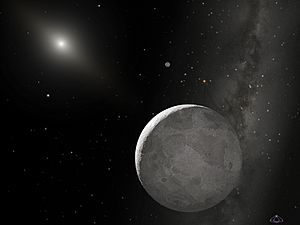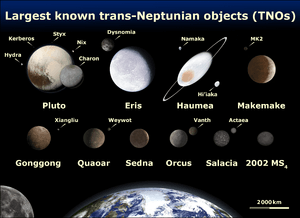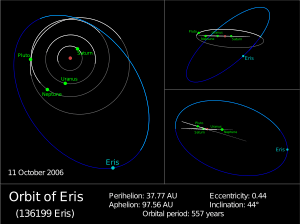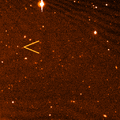Eris (dwarf planet) facts for kids

Eris is a dwarf planet and a trans-Neptunian object. This means it is a small, round object that orbits the Sun, and it is found beyond the planet Neptune. Eris is the second-largest known dwarf planet in our Solar System. It is a little smaller than Pluto, but it actually has more mass (it's heavier) than Pluto.
Eris is also known as a "scattered disc object." This means it's part of a group of icy objects that were "scattered" into unusual orbits by the gravity of giant planets like Neptune. Eris orbits the Sun once every 557 Earth years. Its path around the Sun is not a perfect circle; it's an oval-shaped orbit. This orbit is also tilted at a sharp angle of 44 degrees compared to Earth's path around the Sun.
Because Eris is a dwarf planet beyond Neptune, it is also called a plutoid. This name was given by the International Astronomical Union (IAU) to all dwarf planets in that distant region. Eris has one moon called Dysnomia.
Contents
Discovery of Eris
Eris was found by a team of scientists: Michael E. Brown, Chad Trujillo, and David Rabinowitz. They discovered it on January 5, 2005. They were carefully looking at pictures of the outer Solar System that were taken in 2003.
Naming Eris
Eris was first called Xena. This was after the main character from the TV show Xena: Warrior Princess. But there's a rule for naming objects beyond Neptune. They must be named after characters from mythology.
So, on September 13, 2006, it was officially named Eris. Eris is the name of the goddess of disagreement and fighting in Greek mythology.
Eris's Moon: Dysnomia
Eris has one moon named Dysnomia. Scientists found Dysnomia on September 10, 2005. Just like Eris, its moon was first nicknamed Gabrielle, after another character from the Xena: Warrior Princess TV show.
However, this name also had to be changed to follow the rules. Dysnomia was named after the daughter of Eris in Greek mythology. Dysnomia is known as the goddess or spirit of lawlessness.
Why Eris is a Dwarf Planet
For a while, some news reports, astronomers, and NASA scientists thought Eris might be the tenth planet in our Solar System. But in August 2006, the definition of a planet was changed.
Under the new rules, Eris, along with Pluto, was reclassified. They were both given the new status of a dwarf planet. This means they are big enough to be round but haven't cleared their orbital path of other objects.
Future Studies of Eris
Scientists are still learning more about Eris and its moon, Dysnomia. They are also looking for any other moons or possible rings around Eris. Because Eris is so far away, it would take a space probe about 24.5 years to travel there.
Related pages
| The Solar System | |||||||
|---|---|---|---|---|---|---|---|
|
|
|||||||
| Sun • Heliosphere |
Planets ☾ = moon(s) ∅ = rings |
Mercury | Venus | Earth ☾ | Mars ☾ | ||
| Jupiter ☾ ∅ | Saturn ☾ ∅ | Uranus ☾ ∅ | Neptune ☾ ∅ | ||||
| Dwarf planets | Ceres | Pluto ☾ | Haumea ☾ | Makemake | |||
| Eris ☾ | |||||||
| Small Solar System bodies |
Asteroids (minor planets) |
Groups and families: Vulcanoids · Near-Earth asteroids · Asteroid belt Jupiter Trojans · Centaurs · Neptune Trojans · Asteroid moons · Meteoroids · Pallas · Juno · Vesta · Hygiea · Interamnia · Europa |
|||||
| See also the list of asteroids. | |||||||
| Trans- Neptunians |
Kuiper belt – Plutinos: Orcus · Ixion – Cubewanos: Varuna · Quaoar · Huya |
||||||
| Scattered disc: Sedna | |||||||
| Comets | Periodic comets and non-periodic comets Damocloids · Oort cloud |
||||||
| See also the list of solar system objects | |||||||
Images for kids
See also
 In Spanish: Eris (planeta enano) para niños
In Spanish: Eris (planeta enano) para niños






